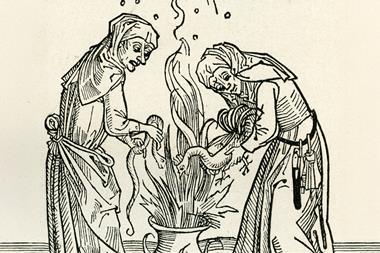The chemical groups that decorate histones are revolutionising cancer therapy at an epigenetic level. Lisa Melton finds out there is more to genetics than genes.
The chemical groups that decorate histones are revolutionising cancer therapy at an epigenetic level. Lisa Melton finds out there is more to genetics than genes.
The more we learn about the human body, the more it appears that our genetic make-up dictates our future. Like a game of cards, health and success await those of us holding the face cards, while those with lower cards must content themselves with a grimmer existence. Genes and fate have become closely entwined.
In cancer, such fatalism rings particularly true. Researchers now know that almost every form of cancer results from an unfortunate combination of genetic predisposition and environmental insults. Genes have emerged as powerful predictors of our susceptibility to malignancies. Yet because DNA is, as yet, impossible to mend, cancer has remained impossible to reverse.
But a seismic shift in attitude is taking place. A group of epigenetic scientists is challenging the view that DNA aberrations are impossible to correct. They claim it is feasible to manipulate, or even reverse, certain types of genetic damage by modifying proteins called histones that actually dictate when genes are switched on and off. It may be an unorthodox line to tow, but epigenetics has rapidly become one of the hottest areas in chemical biology. In a remarkably short time, the findings from basic research have leapt into clinical trials.
The novel strategy hinges on histones - the globular proteins around which DNA strands are entwined and which make up the chromatin. Until a few years ago, these proteins were dismissed as inert scaffolding for DNA. Now it is becoming clear that they play a role in determining which of the 30 000-40 000 genes within each cell are activated and transcribed into proteins.
Attempts to uncover the role of histones began in the 1960s, when Vince Allfrey, working at New York’s Rockefeller University, US, discovered that these globular proteins were decorated with acetyl and methyl groups. Crucially, he also realized that when such chemical marks were lacking, nearby genes tended to be inactive. At the time, it was thought that their controlling effects were due to sterical hindrance, rendering DNA inaccessible to the body’s transcription machinery.
In the mid 1990s, researchers discovered that chemical groups on histone tails actually influence gene expression by forcing the DNA into a more open or compact structure. These epigenetic changes either help or prevent proteins from binding. Crucially, researchers also noticed that these histone modifications are not static. David Allis, of the University of Virginia Medical School in Charlottesville, US, was among the first to recognize that whether a gene is activated or not depends on the exact position of the chemical groups on histone proteins.
Today, Allis is championing the idea that the chemical groups on histones work as a ’code’, controlling each gene individually. A panoply of chemical marks dictating whether genes are switched on or off. ’From a gene’s standpoint, some marks look like green flags that indicate "go", others look like "stop" signs,’ Allis explains. ’The enzymes that put on the flags or take them off would be highly important gene regulators. They act like molecular switches operating almost outside the DNA.’ Acetyls and methyls are the most studied histone modifications, but phosphate groups, ubiquitins and ribosyl groups, all influence whether a gene is expressed.
So although DNA reigns supreme as the ultimate heredity molecule, epigenetic factors appear to be the ultimate controllers. Chemical patterns on histones decide which genes are activated and, unlike DNA, which is immutable, these patterns are constantly changing. There are enzymes that put marks on to histones and others that wipe them off. These latter enzymes are the ones to watch, say researchers. ’In cancer, it looks like many of these enzymes are messed up and de-regulated,’ says Allis. ’If you lose any of the [histone] marks you might inappropriately activate an oncogene or silence a tumour-suppressor gene. The consequences could be disastrous; it might develop into a cancerous state.’
It is good news then that American scientists Paul Marks, from the Memorial Sloan-Kettering Cancer Center in New York, and Ronald Breslow, and his group at Columbia University, have discovered a group of small molecules, hybrid polar hydroxamic acids, that are potent inhibitors of HDAC enzymes. For the past three years research into these HDAC inhibitors has progessed at a healthy rate, resulting in a new biotechnology start-up company: ATON Pharma. Scientists suspect that, in many cancers, HDAC enzymes have gone into overdrive, stripping off acetyl groups from crucial DNA regions, such as those that regulate the activation of tumour-suppressor genes.
Incriminating evidence for the role of HDAC enzymes in cancer formation has been steadily mounting. HDACs have been found to be associated with certain oncogenes and tumour suppressor genes - both major players in the molecular pathways leading to human cancer.
If HDACs were stopped in their tracks, Marks reasoned, an effective anticancer therapy could be developed. The hybrid polar hydroxamic acids inhibit the two main types of HDACs.These compounds are as effective as the theory suggests: they stop cancer cells from growing and differentiating, and induce apoptosis or ’cell suicide’, both in culture and in animal models.
In addition to hydroxamic acids, several other structurally diverse compounds have been discovered that inhibit HDACs. They can be divided into several structural classes (see table), including hydroxamates, cyclic peptides, aliphatic acids, benzamides and electrophilic ketones. Four of these are in clinical trials, but their efficacy varies quite markedly. One of the most potent of these is a small molecule called suberoylanilide hydroxamic acid (SAHA). ’We screened over 700 different compounds that could inhibit HDAC enzymes and arrived at the structure of SAHA,’ says Marks.
Trichostatin A (TSA) was the first discovered natural hydroxamate that inhibits HDACs directly. SAHA is a structurally less complex molecule and is effective at nanomolar concentrations. CBHA and other recently described derivatives including LAQ-824 and sulfonamide hydroxamic acids are also potent HDAC inhibitors.
The structural details of the enzyme-inhibitor interaction were worked out using x-ray crystallography. Marks, and his team, used a HDAC homologue (HDLP) from the hyperthermophilic bacterium Aquifex aeolicus to demonstrate that the hydroxamic acid group, most of the aliphatic chain, and part of the phenyl amino group of SAHA insert into the catalytic site of the enzyme.
In every respect, SAHA fits the criteria for an anti-tumour agent. When tumour cells are cultured with SAHA, they stop growing, while acetylated groups accumulate. In experiments involving animals with prostate cancer, tumours arrest and go into remission with little or no toxicity caused by SAHA. In rats with carcinogen-induced breast cancer, longer studies of up to six months have produced similar results. Even more exciting is the finding that SAHA acts synergistically with radiotherapy, cytotoxic agents and Imatinib - a recently developed, highly selective anticancer drug.
Another key question is which genes are affected by SAHA? Marks and colleagues have found that less than two per cent of expressed genes are altered, but the most commonly induced gene is that of the cell cycle kinase inhibitor ’p21WAF1’. Activating p21WAF1 is no doubt desirable as it stops cancer cells proliferating. SAHA also induces thioredoxin-binding protein-2 expression, which leads to a slump in thioredoxin mRNA levels. This drop in thioredoxin leads to growth arrest and apoptosis - all highly advantageous characteristics for a cancer agent.
But, however promising these laboratory results may be, the make-or-break for any new drug lies in the results of clinical trials. Much anticipation surrounded SAHA’s phase I clinical trials, which included patients with advanced bladder cancers and T-cell lymphomas. ’These people had stopped responding to treatment and were given three months to live by their physicians,’ says Marks. At the higher doses, SAHA produced some dramatic tumour regressions, prompting phase II trials, which are ongoing. Further advantages of SAHA are that it can be given orally and is well tolerated by the body.
So far, the results have been remarkable. One patient has been taking the drug for 20 months, with few side effects, and the disease has remained stable. ’These are wonderful results, but you have to remain circumspect,’ says Marks. ’The cancer field has suffered too many disappointments.’ Despite his words of caution, Marks is enthusiastic and hopes this new compound will soon become a useful addition to the medical armoury. Marks and his colleagues at Columbia University have gone even further and synthesized compounds with 10 times the potency of SAHA.
Crucially, LAQ824 proved to be selective. ’We didn’t want a compound that would just kill any cell. This compound is able to distinguish normal tissue from tumours,’ Atadja explains. When treated with LAQ824, tumour cells auto-destruct and die by apoptosis, while normal cells merely stop dividing but remain unscathed.
Excitement mounted as LAQ824 was tested in mice having xenograft tumours. In this type of model, a few million cancerous cells are implanted under a healthy rodent’s skin where they attach and grow. This provides the ideal setting to test the efficacy of different compounds. Atadja’s team found that LAQ824 and other chemical congeners not only inhibited tumour growth but also induced its regression. ’This is the Holy Grail of tumour treatment,’ says Atadja. In June 2003, clinical trials began, testing the compound in patients with leukaemia and advanced solid tumours. Preliminary results were encouraging.
But how does LAQ824 actually work? What is the molecular and cellular basis for the HDAC anti-tumour activity? Its impact is manifold. Atadja and his colleagues have not only found evidence for cell cycle arrest and cell-suicide by apoptosis, but also signs of an anti-angiogenic effect, which prevents the sprouting of the blood vessels that feed tumours.
The anti-tumour effects of LAQ824 may also occur through the acetylation of the protein ’hsp90’, which is important because it ferries oncoproteins to and fro, protecting them from proteosomal degradation. According to Atadja, the acetylation that follows LAQ824 treatment, forces hsp90 to let go of its deadly cargo which is then degraded. At the same time, HDAC inhibition may activate tumour suppressor genes, such as p21, which add to the anti-tumour activity. With such an array of pathways that converge to produce an anti-tumour effect, the potential of NVP-LAQ824 as an anti-cancer therapeutic looks very good indeed.
Which is the most effective of the known HDACs, is hard to tell. Using antisense experiments Atadja narrowed it down to HDAC1. Surprisingly, suppressing this HDAC isoform alone was sufficient to induce some of the antiproliferative effects seen with LAQ824 treatment.
’We are extremely fortunate for such a young field to already have drugs at a clinical stage’ comments Eric Verdin of the Gladstone Institute of Virology and Immunology, US, who chaired a symposium held at the Novartis Foundation early last year. ’Some of the pictures of tumours disappearing are dramatic. But if we want this field to become successful we need to identify which tumours are sensitive to these drugs.’
Given how widely acetylation is distributed in biology, it is entirely possible to envisage selective inhibitors for each of the HDACs and selective medical application for each one of them. Verdin is cautious but enthusiastic: ’The field is still in its infancy, yet we already have drugs at the clinical stage. Effective HDAC inhibitors have been developed and no doubt we will hear more about their promise as anticancer agents.’
Acknowledgements
Lisa Melton is science writer in residence at the Novartis Foundation
Further Reading
Reversible acetylation of chromatin and non-histone proteins: biology and relevance to human disease Novartis Foundation symposium 259, G Bock and J Goode, editors. John Wiley, April 2004.






No comments yet